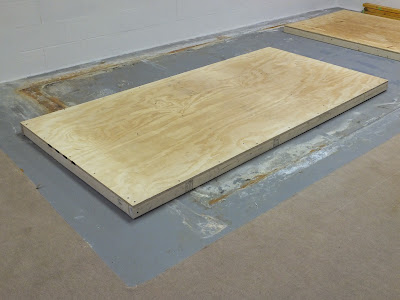Construction involved taking four 19/32" sheets of plywood and ringing them with 2X3 lumber around the perimeter and attaching two 45" joists at 32" intervals. The first two pieces took some time to put together but by the time we got to the third piece we had gotten a rhythm and a system and we polished the last two off quickly and efficiently. I have always found doing this kind of work to be tedious but by the time we got to the fourth piece I had become giddy with happiness. Five hours later (due to breaks to rest our backs) we had four solidly built platform pieces to which we will glue and screw down sheets of homasote once we get the legs attached.
This is our construction site. There used to be an indoor swimming pool here but it was removed. The carpet is soon to be replaced. We wanted to get this first phase completed before the new carpet is installed later this week.
The dehumidifier will keep our trains nice and corrosion-free.
Here you see a stack of furring strips for securing the legs at the bottom and the stack of 40" legs that will be supporting the setup. Home Depot cut all of these to length.
Here is the stack of 2X3's we used to make the support structure for each sheet of plywood.
Here is the incomparably beautiful Gypsy, looking on as we do our work.
The homasote sheeting, cut to size where needed and painted with a primer/paint to reduce dust.
The plywood sits in wait for us to put together.
We placed the long 2X3's beneath each sheet of plywood, then nudged them into place with a hammer, drilled pilot holes and then inserted screws.
Our nascent collection of Kato train stuff.
Our first test setup with the Kato track and a Portram. Not thrilled with the Portram...it moves VERY slowly on the track and is very prone to derailment.
Our first sheet of plywood is done! Note the startling precision with which the wood was cut! We used a tiny Ryobi miter saw to cut the 2X3's to length...it's like a pair of scissors for wood.
The underside of the plywood, revealing the joisting. It's not 16" on center but it does support the weight of two not insignificantly sized men, so it won't have a problem holding up a train set.
The four completed platforms sit on the other side of the basement. Once the carpet is in, we will attach the legs to each of these sheets and get them into position. The first phase of construction is complete!
Check back to see this project as it progresses towards the amazingly detailed and realistic snapshot of American history that it will inevitably become!












